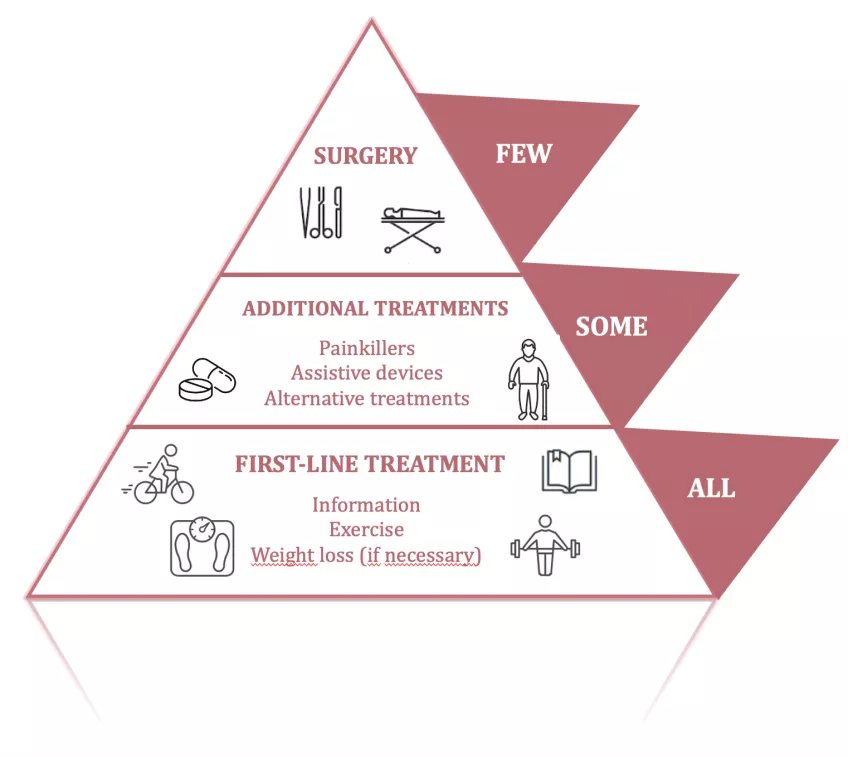OA treatments
Although there is no cure for osteoarthritis, several treatment methods can relieve symptoms and delay disease progression.
Osteoarthritis (OA) treatment can be divided into three sections of a pyramid, with information, regular exercise, and weight loss (if necessary) at the base of the pyramid. The base consists of first-line treatment for OA and should be offered to all individuals living with OA. The middle section of the pyramid includes painkillers, cortisone injections, and assistive devices, and should be seen as an addition to first-line treatment. At the top of the pyramid is surgery, which is really only relevant for a relatively small proportion of patients with OA; those with severe symptoms that have not experienced symptom relief from former treatments. However, most people manage everyday life well solely with first-line treatment, rarely requiring other treatment methods. To avoid "climbing" up the treatment pyramid, it is important to begin first-line treatment as early as possible.
First-line treatment
According to worldwide OA treatment guidelines, information and exercise to manage OA symptoms should be recommended to all OA patients. Learning about OA and understanding the course of the disease is an important first step in managing OA. Unfortunately, many still believe that exercise is bad for OA, especially in instances when exercising hurts. However, by receiving correct and up-to-date information about the joint disease, you understand how vital it is to exercise for your joints to maintain joint health.
Ask a physiotherapist or occupational therapist for help
If you aren’t used to exercising or you aren’t sure how to exercise correctly after being diagnosed with OA, turning to a physiotherapist or occupational therapist for exercise advice is a good first step. If based in Sweden, you can sign up for “osteoarthritis school” to receive information about OA and customized exercise programs from physiotherapists and occupational therapists. Receiving an individualized training program is not necessarily only needed by people with OA who aren’t used to exercising. Sometimes even those who have been exercising their whole life need help with specific exercises to improve functional performance and stability.
It is important to establish an exercise routine and exercise regularly and consistently. Our joints need to move for the articular cartilage to get nutrients and for the muscles around the joints to build strength. Both are necessary to reduce OA symptoms. If you have OA of the hands, several hand exercises can help alleviate OA symptoms. You can also exercise your hands by for example baking or gardening.
Losing weight to manage symptoms
For people who are overweight, losing weight can do wonders for managing OA symptoms. Regular exercise and a healthy diet are essential for sustainable weight loss. A doctor, dietitian, or personal trainer can help you get started if you find it difficult to lose weight by yourself.
Additional treatments
At times when symptoms are unbearable, you may complement first-line with additional treatments such as painkillers or cortisone injections. However, these treatments should only be used for temporary symptom relief. If you feel the need to medicate, make sure to discuss it with your doctor first. Painkillers should not be taken for a long period of time as they can have side effects. Cortisone injections can be prescribed by a doctor to patients that suffer from severe joint inflammation. Keep in mind that cortisone injections only provide temporary symptom relief and will need to be repeated several times. It is also unclear whether the prolonged use of cortisone injections causes damage to the cartilage.
Assistive devices make everyday life easier
As the disease progresses, joint pain may become more intense, making it difficult to move or perform everyday tasks. Several assistive devices/aids are available that can make everyday life easier for people living with OA. The majority of all aids are for individuals with OA of the knees, hips, and hands. Assistive devices can sometimes be borrowed from your healthcare provider but can also be found in special aid shops or your local pharmacy.
Other treatment options
There are several complementary and alternative treatments for pain such as transcutaneous electrical nerve stimulation (TENS). Some individuals experience symptom relief from practicing yoga, tai-chi, and other similar mind-body exercises. Certain supplements and herbal remedies are believed to help with OA symptoms but are not recommended by healthcare professionals as they lack scientific evidence. The placebo effect tends to be behind many of these treatments. However, the placebo effect can be very effective and should not be undermined. Yet, for a treatment method to be recommended by the healthcare system, a proven medical effect in addition to the placebo effect is required. The treatment should also be cost-effective, and the benefits should outweigh the risks.
Surgery
Surgery is considered in cases when no other treatment methods have been able to provide pain relief. Only about 10% of all people with OA require surgery at some point in their lives. The vast majority of surgical procedures performed on patients with OA are knee and hip replacements. The affected joint is then replaced with an artificial joint made from plastic and/or metal.
Other surgical treatments such as joint fusion surgery or osteotomy can also be performed depending on the location of joint damage.
The risks of surgery
All surgical procedures increase the risk of infection and can lead to more or less serious complications. No surgery can guarantee that you will be symptom-free, nor can it guarantee that joint function will be improved. It should therefore always be carefully considered.
Below is a chart comparing the Swedish National Board of Health and Welfare's (Socialstyrelsen) management guidelines for osteoarthritis of the knee and hip with guidelines from:
OARSI - Osteoarthritis Research Society International
AAOS - American Academy of Orthopaedic Surgeons
ACR - American College of Rheumatology
EULAR - European League Against Rheumatism


